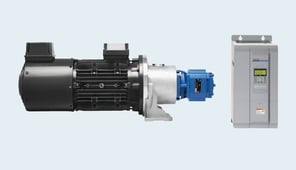Editor’s Note: This blog post has been updated in January 2024 (originally published in July 2022) for accuracy and comprehensiveness
It feels like everyone is looking to reduce emissions and consumption these days - all while still maximizing output, of course, and industrial hydraulics is no different. It's easy enough to say, "we need to be more efficient," but the problems show up when it comes down to actually reducing and maximizing a system, leaving industrial customers wondering, "How do I run a hydraulic system for less?"
Airline partnered with engineers at Bosch Rexroth, who have been innovating the answer to this question for years, to bring their knowledge straight to you. Let's dive into how you can get more out of your hydraulic system using significantly less mechanical energy, downtime, noise, oil, and, ultimately, less money.
Skip to a section:
Less Energy | Hydraulic Pump Efficiency |
Application Example Video | Less Carbon Footprint
Less Noise | Less Oil | Summary & Resources
Less Energy & Downtime
The key to achieving more with less lies in maximizing overall efficiency. However, it is unfortunate that traditional hydraulic systems were not originally designed with hydraulic efficiency of pump in mind. Most applications use fixed-speed electric motors and/or a fixed displacement pump. This leads to a significant energy offset, because the motor runs at full speed for most of the operation, even when unnecessary. 20-80% of a machine's average power using fixed-speed hydraulic pumps is a machine's average power. What happens to all the unused energy? It gets converted to heat, requiring even more power to cool it! Running a system at max speed consistently also makes parts wear faster, causing pumps to wear faster.
Consider: In certain circumstances, it can be beneficial, and even necessary, to quantify the actual efficiency of a hydraulic pump or motor and compare it to its inherent efficiency. This requires a grasp of hydraulic pump and motor efficiency ratings, categorized into three types: volumetric efficiency, mechanical/hydraulic efficiency, and overall efficiency.
Hydraulic Pump Efficiency
Volumetric efficiency:
The ratio of actual flow measured to theoretical hydraulic pump or motor displacement. Volumetric efficiency is usually expressed as a percentage. As the pump wears, and internal leakage increases, volumetric efficiency decreases. This is why new pumps are generally more efficient than older ones.
Mechanical/hydraulic efficiency:
The ratio of shaft horsepower output to the input power, including friction and leakage losses. This is typically measured with a dynamometer. As with volumetric efficiency, mechanical efficiency decreases as internal parts wear. Dynamic efficiency losses also increase the input torque required at the pump shaft.
Overall pump efficiency:
A combination of volumetric and mechanical/hydraulic efficiency. Overall efficiency can be affected by operating conditions such as pressure. The effects of overall efficiency on a fluid system can be estimated using a simple equation: Efficiency = mechanical/hydraulic x volumetric. This equation gives you an idea of the 'lost energy' each pump creates while running. On average, nearly three-quarters of industrial hydraulic systems run at less than 80% efficiency! This results in significant wasted energy and money. An example includes SI units, the required drive power for an external gear pump, and a bent axis piston pump at a flow of 90 liters/minute at 207 bar: External gear pump: 90 x 207 / 600 x 0.85 = 36.5 kW Bent axis piston pump: 90 x 207 / 600 x 0.92 = 33.75 kW, As you'd expect, the more efficient bent axis piston pump requires less drive power for the same output flow and pressure. This also means that a more efficient pump's overall efficiency is higher. |
The solution lies with Variable Speed Pump Drives, which only deliver maximum flow power when you're using it, enabling massive energy, heat, and system wear savings. Watch this minute-long video below for a short application example:
To better understand how these efficiency improvements translate into tangible outcomes, you can watch our 25-minute webinar. It delves into the application breakdowns for each "less" and is available for viewing at any time. Alternatively, if you prefer a condensed overview, you can continue reading.
Less Carbon Footprint
![]()
One of the most impressive benefits of switching to a more efficient system is reducing your organization's carbon footprint (the amount of greenhouse gas emissions a person or organization emits). Lowering an organization's carbon footprint is beneficial for many different reasons. First and foremost, it helps mitigate the effects of global climate change, improves public health, and improves company morale.
Significant financial benefits also help make the switch to energy-efficient pumps worthwhile, as organizations that actively reduce their carbon emissions are often eligible for rewards or subsidies from the government and energy companies. These are often in the form of favorable tax treatment, grants, and low-interest loans.
Less Noise
Hydraulic systems are LOUD, but they don't always have to be! The noise from a hydraulic system comes from the rotational energy put into the motor, the coupling connecting the motor to the pump, the pump internals rotating, and the pressure pulsation noise.
By reducing the rotational speed while the system isn't in use with a Sytronix system, like the DRN Control Drive, you can significantly reduce the system's noise, often by over 10 decibels! Lowering noise levels drastically improves any industrial work environment noticeably, but don't just take my word for it. Listen for yourself!
(VOLUME WARNING!)
Bosch Rexroth Sytronix
 The energy-saving hydraulic design techniques of Sytronix maximize the efficiency of your system to do more with SO much less! Create long-term improvements in your system's efficiency, longevity, and cost of ownership. Of course, that's in addition to reducing your systems' noise output and carbon footprint! Learn More about Syntronix DRn 5020
The energy-saving hydraulic design techniques of Sytronix maximize the efficiency of your system to do more with SO much less! Create long-term improvements in your system's efficiency, longevity, and cost of ownership. Of course, that's in addition to reducing your systems' noise output and carbon footprint! Learn More about Syntronix DRn 5020
Less Oil
The rule of thumb to size a hydraulic oil reservoir says it should be a minimum of 3 to 5 times the maximum hydraulic pump flow so that the oil can properly degas (the air bubbles all rise to the surface). That puts a 40 GPM hydraulic pump at the need of a 120- to 200-gallon reservoir. Optimizing the same output flow path of the oil degassing can reduce the oil volume by four times, thus dropping the oil of a conventional 160-gallon reservoir to only 40 gallons. The material cost savings alone are massive, but this also helps reduce your carbon footprint!

|
For deeper explanations and application examples, watch the full How to Run Your Hydraulics for Less. |
We're Here for Hydraulic Support
At Airline, building hydraulic power units is one of our specialties. We have over 65 years of experience building and servicing hydraulic power units. Even better, we have the capabilities to complete the entire project, including consultation, engineering, manufacturing, installation, field service, and training. Don't hesitate to use us as a resource!









Leave Comment